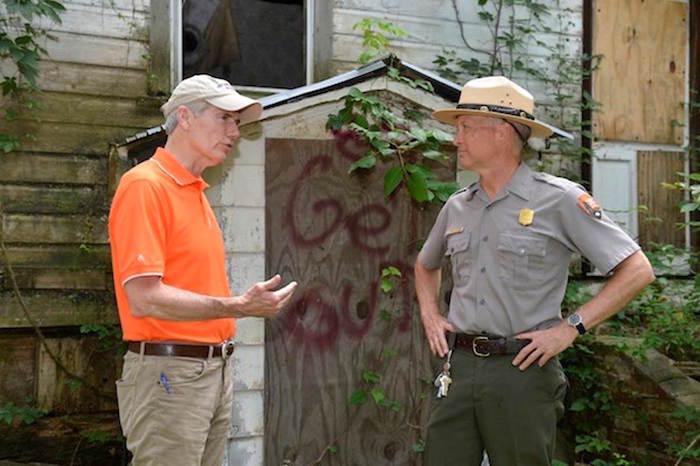
Sen. Rob Portman, R-Ohio, meets with Cuyahoga Valley National Park Superintendent Kenkel to discuss maintenance needs/NPS
U.S. Sen. Rob Portman, who has worked to craft legislation that would address the National Park Service's maintenance backlog of nearly $12 billion, went to Cuyahoga Valley National Park in Ohio to see some of the maintenance problems in person.
On Saturday, the senator toured the national park with Superintendent Craig Kenkel and Deb Yandala, the CEO of Conservancy for Cuyahoga Valley National Park. Recently, Sen. Portman introduced the Restore Our Parks Act, bipartisan legislation that would help address the nearly $12 billion maintenance backlog. The measure would establish the “National Park Service Legacy Restoration Fund” to reduce the maintenance backlog by allocating existing unobligated revenues the government receives from on and offshore energy development.
The measure, which could make up to $1.3 billion a year available to address the backlogged maintenance, would help tackle the more than $100 million in maintenance needs at Ohio’s eight national park sites. Specifically, Cuyahoga Valley National Park has more than $45 million in unmet maintenance needs such as building renovations, road, and infrastructure improvements.
“Today I visited one of Ohio’s most important treasures, the Cuyahoga Valley National Park, and was able to see firsthand the unmet maintenance needs that need urgent attention. This includes rehabilitating and refurbishing existing structures like the Station Road Bridge that I saw, as well as, stabilizing railroads and trails that we walked today,” said Sen. Portman. “Whether biking, fishing, kayaking, or hiking with my family, I’m proud to be one of the 2.7 million visitors to Ohio’s national parks annually. ... These parks are national treasures and we must do our part to ensure that these parks can be enjoyed for many generations to come.”
Portman has long been a leader in the U.S. Senate in efforts to protect our national parks. He is the author of the National Park Service Centennial Act, legislation signed into law in 2016 that authorizes the National Park Centennial Challenge Fund and the Second Century Endowment Fund, two public-private partnerships that will help preserve our national parks for generations to come. Last year, the Republican received the National Park Foundation’s Centennial Champion Award for his work on the National Park Service Centennial Act. He has previously received the 2012 NPCA Centennial Award, the 2015 Bruce F. Vento Public Service Award, and the Cuyahoga Valley National Park Centennial Leader Award.



Comments
Yeah - I get the mechanics about designating a national park. But I always thought that it mean the "crown jewels" and always with impressive natural features. Cuyahoga Valley National Recreation Area sounded just about right. When Pinnacles got its designation as a national park, it was because Congressman Sam Farr pushed it, hoping that it would bring in tourists. Strangely enough it didn't, as visitation was highest the year before the designation, with a sharp dropoff following the redesignation. I still don't get it. I don't agree with the proposal to turn Golden Gate NRA into a fully designated national park either.
I never quite understood why Death Valley and Joshua Tree had their national monument designations for so long, but eventually that was fixed. I guess Hot Springs was kind of early in the process. Weren't there some small national parks that were delisted? I'm not sure there really needed to be a General Grant National Park, but that was before there was an NPS and there were alternate designations.
Or is it more about money? Cuyahoga was -- when I was growing up nearby -- a really nice municipal park system. Mostly owned by the City of Cleveland, if I remember correctly. At the time it was being pushed to become part of the NPS system I was long gone to some western parks, but do recall that there were some objecions at the time because it was apparent that Cleveland wanted to get out from under the cost of operating and maintaining the place. I haven't done it, but bet that if anyone looked into the history, they'd discover a flock of Ohio Congressfolks behind it all. Transfer expenses from local taxpayers to all of us while gaining a few dozen brownie points with local voters.
Like CUYA - look at Gateway in New York. NYC gave it ot NPS in early 1970's and NPS gladly took it. It is now the top ranked deferred maintenance park in the system (it has the most). It has always been a challenge there but I think the current NPS team is doing the best anyone can expect.
I look at GGNRA in and around San Francisco, which is a combination of land given to NPS to manage from various sources including the US Army, City and County of San Francisco, etc. That has a real patchwork of funding sources - especially The Presidio, which is supposed to be self-sufficient via commercial and non-profit operations that lease buildings/land from The Presidio Trust. That's kind of a unique setup for NPS, although I'm not sure it could be replicated. The other crazy thing is all the controversy over dogs, since San Francisco attached conditions regarding dog access when it gave several pieces of land to NPS to manage.
As for similar park systems, we have a pretty nice regional park system near where I live. They have some money-making ventures like a merry-go-round and other cool stuff. However, I believe the bulk of their funding comes from general funds from the counties and special taxes added to our property tax bills.
The legistlation is intended to address the $12 billion deferred maintenance of the entire national park system, including the units of Ohio.